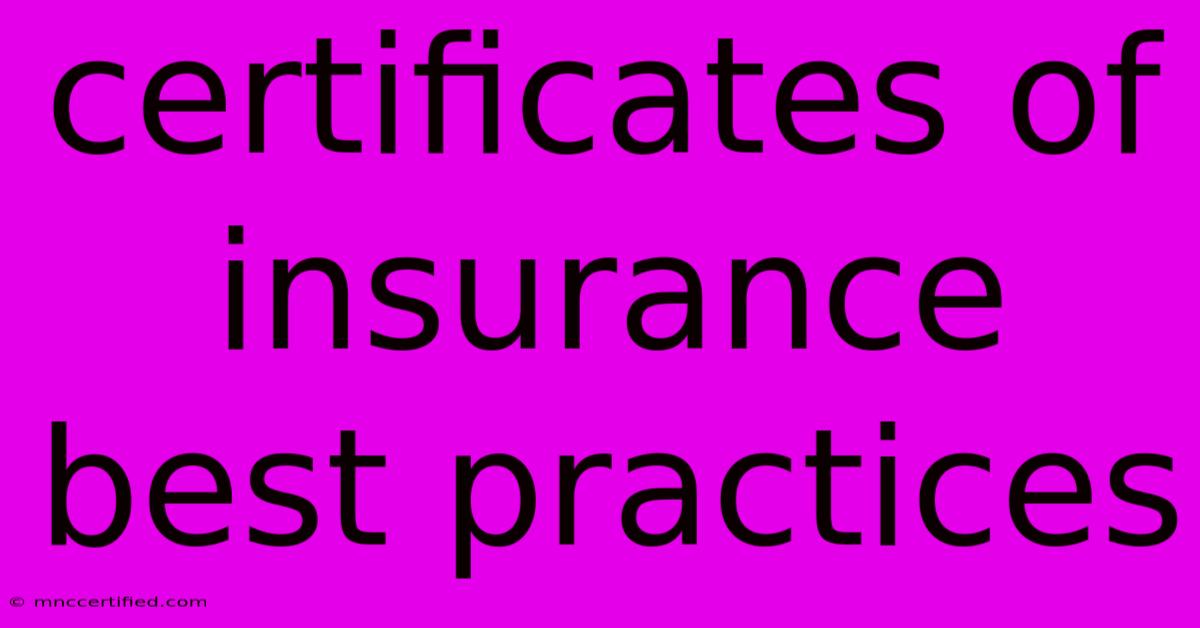Certificates Of Insurance Best Practices

Table of Contents
Certificates of Insurance: Best Practices for a Secure Business
Certificates of insurance (COIs) are essential documents for any business. They prove that you have the necessary insurance coverage to protect yourself and your clients. But what exactly makes a good COI, and how can you ensure you're using them effectively?
This article delves into the best practices for COIs, covering everything from obtaining to reviewing these crucial documents.
Understanding Certificates of Insurance
A COI is a formal document issued by an insurance company confirming the existence of an insurance policy. It outlines the policy's key details, including:
- Policyholder's Name: The insured party.
- Policy Number: A unique identifier for the policy.
- Type of Coverage: Specifies the insurance coverage, such as general liability, workers' compensation, or professional liability.
- Limits of Liability: The maximum amount the insurer will pay for covered claims.
- Effective Dates: The start and end dates of the policy's coverage.
- Additional Insured Parties: Individuals or entities specifically named on the policy as additional insured parties.
Why Are Certificates of Insurance Important?
COIs serve several crucial purposes:
- Proof of Coverage: They act as concrete evidence that you have the required insurance coverage.
- Risk Mitigation: They provide assurance to clients, partners, and vendors that you can handle potential financial risks associated with your business.
- Contractual Obligations: Many contracts require you to provide COIs as a condition of doing business.
- Legal Protection: In case of an accident or incident, a COI can safeguard you from financial losses.
Best Practices for Obtaining Certificates of Insurance
Here's a guide to ensure you get the most out of your COIs:
1. Request COIs for All Parties: Whenever you enter into an agreement or contract, ensure that you request a COI from all parties involved, including clients, vendors, subcontractors, and partners.
2. Specify Coverage Requirements: Clearly outline the specific types of coverage and limits you need for each situation. This ensures the COIs meet your specific requirements.
3. Establish a COI Review Process: Develop a standardized process for receiving, reviewing, and storing COIs. This ensures consistency and eliminates potential oversights.
4. Use a COI Tracking System: Implement a system for managing and tracking COIs. This could include a spreadsheet, database, or dedicated software. This helps you keep track of expiration dates and ensures you have the most up-to-date information.
Best Practices for Reviewing Certificates of Insurance
Once you receive a COI, it's crucial to review it thoroughly to ensure it meets your needs:
1. Verify Policy Details: Compare the information on the COI to your own records to verify that the policyholder, policy number, and coverage details are accurate.
2. Check Limits of Liability: Confirm that the limits of liability are sufficient for your needs.
3. Identify Additional Insured Parties: Review the COI to see if you are listed as an additional insured party, as this is essential for your protection.
4. Look for Exclusions and Limitations: Pay close attention to any exclusions or limitations within the policy coverage.
5. Check Expiration Dates: Ensure that the COI's coverage period aligns with your project timeline.
6. Get a Signed and Stamped Original: Ensure you receive a signed and stamped original COI from the insurance company. This adds validity and legal weight to the document.
Keeping Your Certificates of Insurance Up-to-Date
Maintaining current COIs is vital.
1. Request Updates When Needed: Regularly request updated COIs from your clients and partners, especially when:
- Existing COIs are nearing expiration dates.
- There are changes to the insurance policy, such as policy renewals or coverage modifications.
- There are changes to the parties involved in the agreement.
2. Store COIs Securely: Implement a secure system for storing and accessing COIs. This may involve a physical file system or a secure digital storage solution.
Conclusion: Certificates of Insurance for Business Success
COIs are an essential part of risk management and legal protection for any business. By following the best practices outlined above, you can ensure that you have the right insurance coverage and protect your company from potential liabilities. Remember, a well-organized and proactive approach to COIs is crucial for a secure and successful business.

Thank you for visiting our website wich cover about Certificates Of Insurance Best Practices. We hope the information provided has been useful to you. Feel free to contact us if you have any questions or need further assistance. See you next time and dont miss to bookmark.
Featured Posts
-
Do You Need Insurance For A Boat Trailer
Nov 08, 2024
-
Velocity Investments Llc Upstart Reviews
Nov 08, 2024
-
Does Dental Insurance Cover Gum Grafting
Nov 08, 2024
-
Live Chelsea Vs Fc Noah Conference League Match
Nov 08, 2024
-
Outer Banks Season 5 Renewal And Updates
Nov 08, 2024